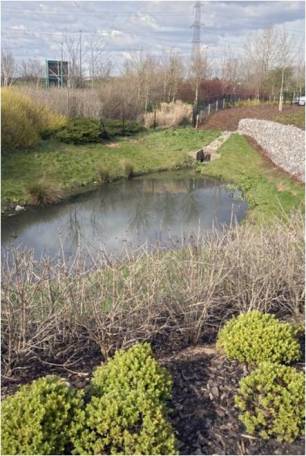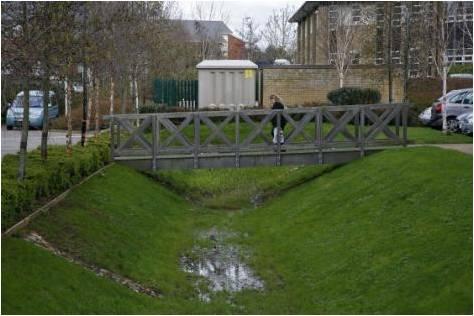Where
Location
Bristol Business Park is in Frenchay, north of Bristol approximately 1km west of the M4/M32 junction, and is accessed from Coldharbour Lane using a roundabout which also gives access to the University of the West of England.
Description
Bristol & England Properties was developing 11.6 Ha of land as an office business park on a phased basis, comprising buildings of approximately 1,000m². to 2,000m². The site occupies the brow of a hill and the runoff falls into four catchments involving temporary drainage arrangements during the phased construction. The site is underlain by stiff to hard clays of the Mercia Mudstone Group (Keuper Marl).
|
|
|
Figure 1 Detention pond - provides a valuable |
SuDS used
Permeable paving has been used in the Phase 3 parking areas with a total site area of approximately 1.2 Ha. Discharges from this paving connect to swales, which in turn are conveyed by a conventional gravity drainage system carrying earlier conventionally paved phases through a wet detention pond, through a control feature (Hydrobrake) which discharges into an off-site watercourse. Runoff from the roofs of the Phase 3 development also discharge into the permeable paving.
How it works
The car parking areas are surfaced with a mixture of permeable and impermeable paving supplied by Formpave, with a porous sub-base running throughout. Rainwater falling on the permeable paving flows through the gaps into the underlying porous sub-base. The impermeable aisles are laid to falls so that the runoff is shed to the permeable paving, where it discharges through the joints into the underlying gravel. Rainwater downpipes from the roofs discharge into shallow pipes via small accessible silt traps, distributing water into the porous gravel through a simple tree branch pipe arrangement to aid dispersal. Concern over the possibility of clay heave and shrinkage, resulted in the inclusion of an impermeable liner below the sub-base, tucked up the sides. Discharge pipes of 100m diameter convey flows to the swales.
Specific details
Because the site has been developed on a phased basis, the drainage designs have been dictated by the capacity of the four catchments. The last phase to be completed (Phase 3) was within a catchment drained by a small watercourse which begins near the boundary of the site, and which downstream has a very shallow bed adjacent to a road which frequently floods. It was therefore important to minimise any increase in the risk of flooding. It is also planning policy of South Gloucestershire Council (the Local Authority) that all new developments should incorporate sustainable drainage (SuDS). The original plan was to form a large wet detention pond with a controlled outlet restricting flows to the agricultural runoff intensity. However, the Developer was keen to maximise the development area, and also have high quality landscaped ponds in prominent areas within the development, rather than in the ‘back’ of the development where the large detention pond would need to be.
The Phase 3 permeable system connects into an existing system which already incorporated a small wet detention pond.
The Formpave system comprises paving blocks with ‘notches’ formed in the ends to allow water to flow through to the bedding material, and yet maintain the normal interlocking to form the pavement. Fine gravel bedding was used, placed on a porous geofabric separation membrane. Below this is punctured macadam, over approximately 350mm of porous gravel. The bedding layer performs the water quality improvement function, and the porous gravel performs the storage function.
|
|
|
Figure 2 Swales, which take water from the paving, create attractive features in the business park (CABE/Stephen McLaren) |
Design & construction
The Construction was procured using a Design and Construct contract, but the permeable paving was a condition of the Employer’s Requirements, and installed largely in accordance with the original scheme. The contractor decided to place the porous gravel early in the Contract, and protect it with a layer of macadam, which was later punctured prior to installing the bedding layer and paving blocks.
The services, drainage and ducts consequently needed to be installed at a very early stage in the Contract, to avoid subsequent contamination of the porous gravel or damage to the impermeable membrane.
The paving was laid towards the end of the Contract, and care needed to be taken with topsoil and sand deliveries to avoid blocking the gaps between the blocks.
Benefits & achievements
Benefit: Permeable paving minimised loss of land to detention ponds.
Benefit: Permeable paving and short swales satisfied the SuDS planning policy of the Local Authority.
Challenges & lessons learned
Barrier: The permeable paving required careful programming on site and early installation of services and drainage.
Barrier: Care was needed to avoid contamination of the system at all stages, especially from sand, topsoil etc.
Lesson learned: The pavement has been observed during and after a range of heavy and prolonged storms, and only negligible flows have been observed discharging into the swales, demonstrating the attenuating attribute of the paving system.
The information on Bristol Business Park was provided by the designer: Clive Onions.





